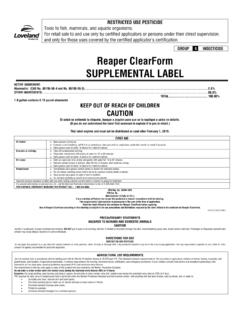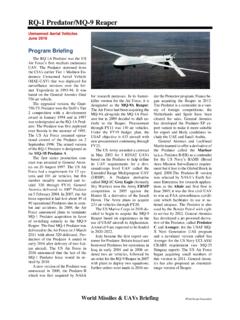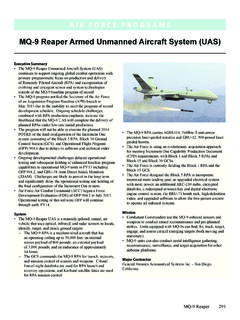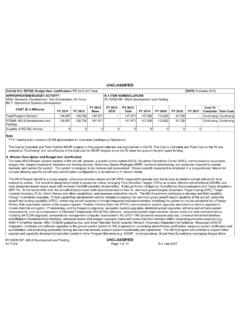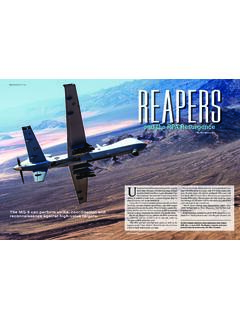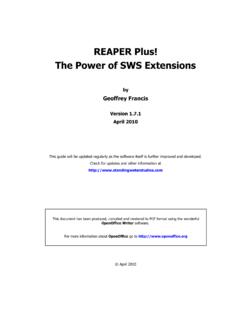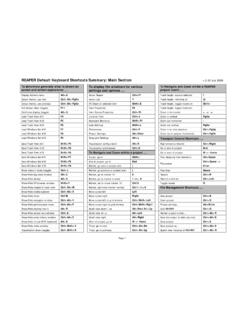Transcription of Material Safety Data Sheet REAPER - AgchemAccess
1 Material Safety data Sheet REAPER 1. Identification of the substance/preparation and company/undertaking: MAPP Number: MAPP 14924 Trade Name: REAPER Recommended Uses: Herbicide for weed control or desiccation in a range of agricultural, forestry, aquatic and horticultural crops. Manufacturer/Supplier: AgchemAccess Ltd Pure House 64-66 Westwick Street Norwich NR2 4SZ United Kingdom Telephone number: +44 (0) 1603 624413 Fax Number: +44 (0) 1603 616993 e-mail: Emergency Telephone Nos: 023 8040 7831 [ AgchemAccess 24 hrs.] 0870-600-6266 [UK National Poisons Control Information Service (NPIS) Centre] 01-8379964/66 [Poisons Information Centre, Beaumont Hospital, Beaumont, Dublin 9, Ireland] 2. Composition/Information on Ingredients: HAZARDOUS COMPONENTS: Component CAS EINECS Conc.
2 Risk Hazard Reg. No. ELINCS No. % w/w Phrases* Symbol Glyphosate isopropyl amine salt 38641-94-0 254-056-8 41 R51, 53 N Surfactants - - - - - Plus water to make up the balance. * See Section 16 for details of risk phrases. 3. Hazards Identification Health hazards: Slightly irritating to skin and eyes. Environmental hazard in case of accident (spillage or leakage): Toxic to aquatic organisms; may cause long term adverse effects in the aquatic environment. 4. First Aid Measures General: Have the product container, label or Materials Safety data Sheet with you when calling the Poisons Information Service, AgchemAccess , a physician or when going for medical treatment. Move out of contaminated area and place victim in the recovery position if necessary. Remove contaminated clothing and dispose of safely. Skin Contact: Wash affected area immediately with plenty of water.
3 Remove contaminated clothing and wash thoroughly before re-use. If irritation persists, call a physician. Eye Contact: Rinse immediately with plenty of water for at least 15 minutes, including under eyelids. Remove contact lenses if worn. Call an eye specialist or the poison control centre if irritation persists. Inhalation: Remove patient to fresh air and seek medical advice. Keep the patient warm and at rest. Administer artificial respiration if the patients breathing is irregular or has stopped. Contact a physician or the Poison Control Centre immediately if the patient feels unwell. Ingestion: If swallowed, rinse mouth with clean water and dispose of residues safely. Then dilute ingested Material by drinking milk and consult a physician. Guide to Doctors: This product is a glycine herbicide of low toxicity but there is no specific antidote.
4 Treat symptoms as they arise. Ingestion may result in nausea and vomiting with possible diarrhoea. Ingestion of very large amounts may cause hypertension and lung oedema. 5. Fire-fighting measures: Extinguishing Media for small fires: Use alcohol-resistant foam, dry chemical ( sand) or carbon dioxide. Extinguishing Media for larger fires: Use alcohol-resistant foam or a water spray. Extinguishing Media which should not be used for Safety reasons: DO NOT USE a solid water stream as this may scatter and spread the fire. Specific hazards during fire-fighting: During a fire dense black smoke may be produced. This will contain the products of combustion which may be toxic. Evacuate downwind. Special protective equipment for fire-fighters: Wear full protective clothing and self-contained breathing apparatus. DO NOT breathe fumes. Further Information: Contain fire-fighting water with sand or some such bunding Material to prevent entry to drains or water courses.
5 Avoid breathing smoke. Cool closed containers exposed to the fire with a water spray. 6. Accidental release measures: Personal precautionary measures: Wear the personal protective equipment outlined in section 8 below. Remove contaminated clothing immediately. Wash skin area with soap and water. Wash clothing before re-use. Environmental protection measures: Keep the area isolated and do not allow contamination to enter drains or waterways. Prevent further leakage if safe to do so. Spillage or uncontrolled discharges into watercourses must be alerted to the National Rivers Authority or Environmental Agency (Tel: 0800 807060). Procedures for cleaning/absorption: Soak up with sand, earth or other non-combustible absorbent Material using mechanical handling equipment and place in containers for disposal according to local/national regulations (see section 13).
6 Clean contaminated floors and objects thoroughly and dispose of cleaning equipment safely. For large spillages, barricade the area and consult the manufacturer. 7. Handling and storage: Handling: Use the personal protective equipment detailed in section 8. Avoid contact with eyes. Do not store, mix or apply this product in galvanised or un-lined steel containers. Containers for the neat or diluted product must be stainless steel, aluminium, fibre-glass, plastic (HDPE or PET) or plastic-lined vessels. When using, do not eat, drink or smoke and wash hands and exposed skin after work. Storage: Store in a cool dry and well-ventilated place in the original containers away from any source of ignition and protect from excessive heat or cold. Keep in an area accessible to authorised personnel only. Keep out of reach of children and store away from food, drink and animal feeding stuffs.
7 Additional information: The product is stable for at least two years when stored at ambient temperatures in the unopened container. Ensure temperature does not exceed 40 C. 8. Exposure controls/Personal protection: Engineering measures to reduce exposure: Engineering controls to avoid exposure are preferable to personal protective equipment where practically feasible to use. Good general ventilation is sufficient for most operations. Assess the exposure and deploy additional measures if there is a chance that the relevant exposure limit may be exceeded. Personal protective equipment: Avoid contact with skin, eyes or clothing. Keep work clothes separate from other clothing. Clothing that cannot be cleaned should be burned. When using, consult the label for appropriate protective equipment. In all other situations, use the following personal protective equipment.
8 Eye protection: Follow local site procedure. A face shield to BS2092 is required when handling the concentrate or contaminated surfaces. Hand protection: Chemical-resistant gloves made of nitrile rubber are needed with a breakthrough time appropriate to the length of exposure. Wash contamination from the gloves immediately and dispose of safely if perforated or contaminated on the inside. Wash hands before eating, drinking or smoking and before using the toilet. Respiratory protection: Avoid breathing the spray mist. Use a filter respirator with a pesticide canister. Note that these provide limited protection and in the event of an emergency spillage or where the exposure level is unknown, self-contained breathing apparatus should be used. Skin and body protection: Wear suitable protective clothing based on the potential exposure risk over normal clothes to provide two barriers.
9 When finished, wash with soap and water after removing protective clothing. Take a shower if necessary. Decontaminate clothing before re-use or use disposable clothing. Do not eat, drink or smoke while working. Store away from food, drink or animal feeding stuffs. 9. Physical and chemical properties: Appearance: Liquid. Formulation: Soluble concentrate. Colour: Amber. Odour: Slightly amine. Vapour pressure: mm Hg at 25 C (glyphosate fee acid) pH: Specific gravity: g/cm3 @ 20 C Flash point: > 70 C Boiling point: > 100 C Water solubility: Completely soluble. Kinematic Viscosity: mPas at 25 C 10. Stability and reactivity: Hazardous decomposition products: Product is very stable when stored as directed. Hazardous reactions: Stable under normal conditions and hazardous polymerisation does not occur. Avoid contact with strong alkalis and contact with galvanised or unlined steel since contact can cause the release of hydrogen.
10 This is a highly combustible gas which can flash-ignite or explode, causing severe injury. 11. Toxicological information: Oral toxicity (LD50): >5000 mg/kg (rat) Acute dermal toxicity (LD50): >5000 mg/kg (rabbit). Inhalation toxicity (LC50): mg/l, exposure 4 hours (rat). Skin irritation: Non-irritating to skin Eye irritation: Mildly irritating to eyes. Sensitisation: Does not cause sensitisation. Note: Has been shown to be non-carcinogenic, not mutagenic and not teratogenic. 12. Ecological information: Ecotoxilogical effects: Toxicity to fish (LC50): >1000 mg/l (Onchorhyncus mykiss [rainbow trout]). Exposure time 96 hours. Toxicity to algae (EC50): 189 mg/l (Selenastrum spp.). Exposure time 96 hours. Toxicity to aquatic 610 mg/l (Daphnia magna [water flea]). Invertebrates (EC50): Exposure time 48 hours. 13. Disposal considerations: Waste from residues and unused product: In accordance with current regulations after consultation with a disposal site operator and/or the responsible authority, this product may be taken to a waste disposal site or an incineration plant.


